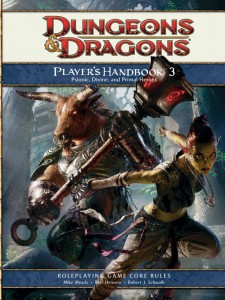More often than not, the PC who poses the greatest threat on the battlefield isn’t the heavily armored Fighter swinging a greatsword but the dagger-wielding Rogue in leather armor. Strikers are designed to inflict a lot of damage. The trade off is that these classes sacrifice high defenses. In general, strikers are soft. This becomes painfully apparent when the guy with the lowest defenses is singled out and starts taking attacks from everyone not marked by a defender (and even a few of them too).
Tag: D&D
Effective Use Of Weather
 I was cleaning out my dice bag the other day when I came across an old gem, the weather die. It’s been years since I’ve seen it, and probably over a decade since I’ve used it in a game. These days the only random element to the game I enjoy are when the PCs take a right turn when I was expecting a left. To me, and I know others will disagree, random encounter detract from the central story that is being told. Random weather is well, random and pointless.
I was cleaning out my dice bag the other day when I came across an old gem, the weather die. It’s been years since I’ve seen it, and probably over a decade since I’ve used it in a game. These days the only random element to the game I enjoy are when the PCs take a right turn when I was expecting a left. To me, and I know others will disagree, random encounter detract from the central story that is being told. Random weather is well, random and pointless.
Training in Insight does not make you a human lie detector. Too often in D&D a PC rolls Insight and on a successful check knows immediately if a person is lying. This shouldn’t always be the case. Sometimes you need to work at it. If you’ve never met this person before how do you know that they’re lying. Everybody lies to some extent. Figuring out if the lie they just told you impacts your current line of questioning or not requires work.
For situations where more than one simple roll is required, a structured skill challenge may be more suitable. This is not to say that every attempt to detect a falsehood requires anything this complex, but it might be a good idea to remind the PCs that sifting through an intricate web of lies often takes time and many skill checks.
In February’s issue of Dungeon (#173), Craig A. Campbell has created a three-encounter delve called Haruuc’s Tomb: A Novel Adventure based on events from Don Bassingthwaite’s fantastic Eberron novel, Word of Traitors. As a big fan of Eberron and a huge fan of this book I was very concerned about how this adventure would turn out. But before I get into the good and bad of Campbell’s undertaking I have a questions for all the players. Have you ever played an adventure that was inspired from a D&D novel?
Psionics. I’ll admit that over the years I’ve never been a huge fan of psionics in D&D. I cringed when Wizards announced that PHB3 would introduce psionic powered character classes to 4e D&D. My initial (and completely uninformed) opinion on the matter was that psionics suck. However, over the past few months as preview material was released through DDI, I got a chance to see some of these new psionic classes first hand. I’ll admit that the preview content started bringing me around on psionics. Now that I’ve actually got a PHB3 with the full builds for each of the new psionic classes I find myself completely turned around on psionics.
In our Player’s Handbook 3 Review (Part 1) we covered the new races and the new divine leader class, the Runepriest. In Player’s Handbook 3 Review (Part 2) we covered skill powers, feats and new magic items. In today’s article we’ll look at psionics.
 I’m all about options, I love to have a multitude of choices, doing the research and then selecting the best fit for the vision of my character. These choices don’t just include the feats and powers I select for my PC, in fact the decisions start the moment I open up the Character Builder. I’m first confronted with the choice of what class to play, followed by race and so on. While these two early choices may seem simple, they are anything but. They will serve to represent your character as much or more than any other choice you make.
I’m all about options, I love to have a multitude of choices, doing the research and then selecting the best fit for the vision of my character. These choices don’t just include the feats and powers I select for my PC, in fact the decisions start the moment I open up the Character Builder. I’m first confronted with the choice of what class to play, followed by race and so on. While these two early choices may seem simple, they are anything but. They will serve to represent your character as much or more than any other choice you make.
In our Player’s Handbook 3 Review (Part 1) we looked at the new Shardmind race and one of the new classes, the Runepriest. Today in our PHB3 Review (Part 2) we’re looking at skill powers, feats, superior implements and new magic items. In our PHB3 Review (Part 3) we’ll delve into a detailed look at the psionic classes.
 Here’s a quick recap of the new races and classes available in the PHB3.
Here’s a quick recap of the new races and classes available in the PHB3.
New Races
- Githzerai
- Minotaur
- Shardmind
- Wilden
New Classes
- Ardent (psionic, leader)
- Battlemind (psionic, defender)
- Monk (psionic, striker)
- Psion (psionic, controller)
- Runepriest (divine, leader)
- Seeker (primal, controller)
There are also complete rules for building Hybrid characters of all classes (including all six new classes introduced in the PHB3).
 You may think that you know what the Player’s Handbook 3 is all about if you’ve got a DDI subscription, but the preview content was just the tip of the iceberg. If you’re a DDI subscribers who’s considering passing on the PHB3, think again. This is one of the coolest 4e D&D books that’s come out so far.
You may think that you know what the Player’s Handbook 3 is all about if you’ve got a DDI subscription, but the preview content was just the tip of the iceberg. If you’re a DDI subscribers who’s considering passing on the PHB3, think again. This is one of the coolest 4e D&D books that’s come out so far.
The PHB3 comes out next week on Tuesday, March 16, but for those of us living in the Greater Toronto Area it came out this past Friday. I visited three gaming stores and a major book selling chain and they all had it proudly displayed for sale. I don’t know if this complete disregard for the street date is limited to my area or if this is the case across the board. All I know is that I was fortunate enough to get my copy of the PHB3 Friday and I haven’t put it down since.
I took some flack for my Martial Power 2 review last month. Some readers didn’t think I spent enough time giving my opinion. With my review of the PHB3 I’m going to listen to the readers and do more than just tell you what’s in the book. But given the amount of material in the PHB3 it’s going to take more than one article to cover everything. So as seems fitting, I’m going to break my review of the PHB 3 into three parts. Today we’ll look at the new races and one of the new classes – the Runepriest.
The Evolution of the Dungeon Encounter
“Hey what dat noise?”
“What noise dat you talk’n bout Oloorin?”
“Sounds like fight’n, maybe we go see?”
“Wha you talk’n bout? We have important job, we guard chest in 10 x 10 room. We stay put.”
“Uh… ok, if you say. What we do if someone come through dat door?”
“Probably we die. Dat da life of two orcs guarding chest in room.”
Sound familiar? Ok, maybe I’ve gone a bit too far with some stereotypes, but how many DMs have designed a dungeon that had a room with a few monster that just waited for the door to open?
This morning Ameron shared his thoughts on the new monster makeover Wizards announced yesterday. I’ve looked at the new format and thought a lot about it myself. Here are my initial impressions, with a little background to justify my thoughts.
I’m a secondary school teacher. My main “teachables” are math and computer studies. One of the computer courses I teach deals in part with the design and layout of graphics in order to more effectively convey a message or disseminate important information. It is amazing what a simple rearrangement and regrouping can do in this regard. With this in mind I must say that the DM in me has a good feeling about the upcoming changes to the monster stat blocks.